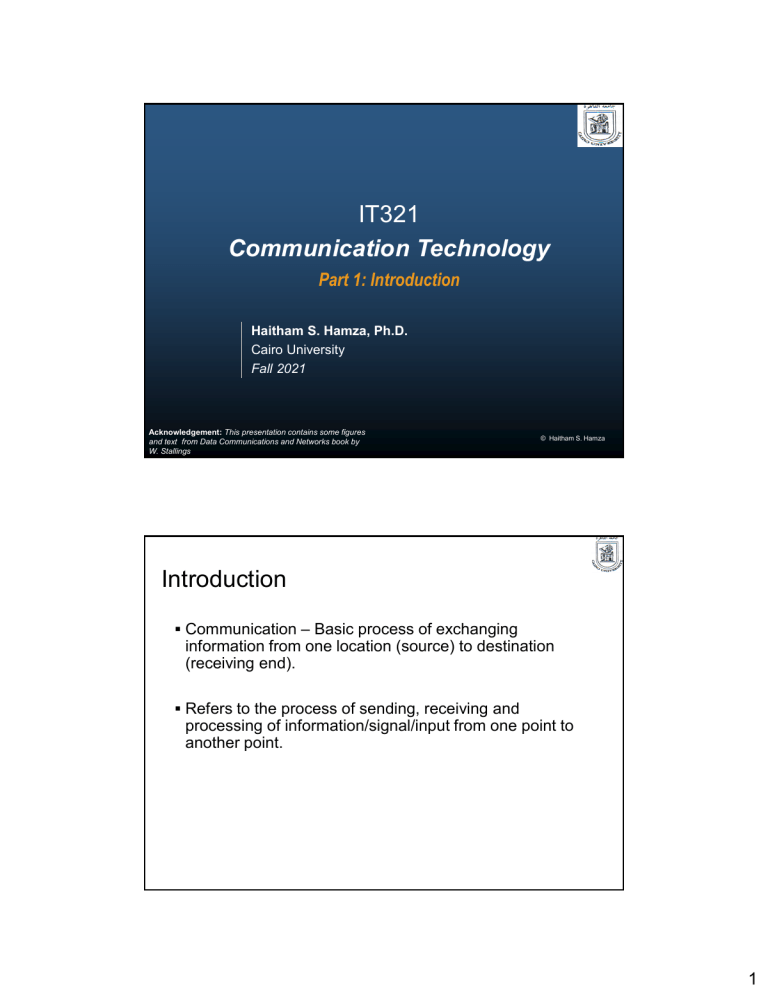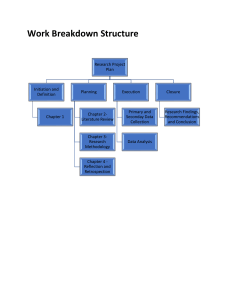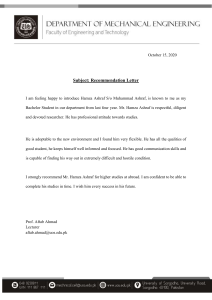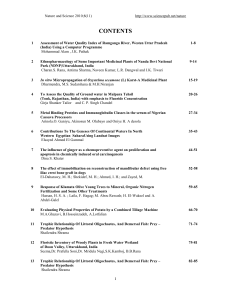
IT321 Communication Technology Part 1: Introduction Haitham S. Hamza, Ph.D. Cairo University Fall 2021 Acknowledgement: This presentation contains some figures and text from Data Communications and Networks book by W. Stallings © Haitham S. Hamza Introduction Communication – Basic process of exchanging information from one location (source) to destination (receiving end). Refers to the process of sending, receiving and processing of information/signal/input from one point to another point. 2 © Haitham S. Hamza 1 Goal of communication systems Transmit and Receive information under noisy channel (e.g., AWGN) with: • small power (energy) SNR • small error Probability of Error © Haitham S. Hamza Communication Systems Components Any communication system consists of three basic blocks: • Transmitter • Receiver • Communication Channel Source Transmitter Channel Receiver Recipient A transmitter prepares the data (information) to be transmitted in the appropriate format in order to be transmitted over the communication channel. 4 © Haitham S. Hamza 2 Communication System Components (cont.) © Haitham S. Hamza Communication System Components (cont.) •Information Source • • • Generates the message(s) . Examples are voice, television picture, computer key board, etc.. If the message is not electrical, a transducer is used to convert it into an electrical signal. Source can be analog or digital. © Haitham S. Hamza 3 Communication System Components (cont.) •Source encoder/decoder • • • • The source encoder maps the signal produced by the source into a digital form (for both analog and digital). The mapping is done so as to remove redundancy in the output signal and also to represent the original signal as efficiency as possible (using as few bits as possible). The mapping must be such that an inverse operation (source decoding) can be easily done. Primary objective of source encoding/decoding is to reduce bandwidth, while maintaining adequate signal fidelity. © Haitham S. Hamza Communication System Components (cont.) • Channel encoder/decoder • • • Maps the input digital signal into another digital signal in such a way that the noise will be minimized. Channel coding thus provides for reliable communication over a noisy channel. Redundancy is introduced at the channel encoder and exploited at the decoder to correct errors. • Modulator • • Modulation provides for efficient transmission of the signal over channel. Most modulation schemes impress the information on either the amplitude, phase or frequency of a sinusoid. © Haitham S. Hamza 4 Examples of Wired Comm. Channels 9 © Haitham S. Hamza Why Different Types of Comm. Systems? There are several factors that give rise to the need for different types of communication systems: • The nature of the communication channel (undersea communication requires optical fiber cables) • The nature of the application (mobile applications needs wireless systems) • Required level of quality (performance and quality of the received signal) • Cost 10 © Haitham S. Hamza 5 Spectrum of Telecomm Systems 11 © Haitham S. Hamza Problems that Face Comm. Systems Any communication system can be subject to three main sources of problems: 1. Noise: undesired effect from the communication environment. Usually, it is not under our control (your system has to deal with it). 2. Interference: due to superposition of two or more signals. May result from bad design of communication systems (interference of voice channels in telephone systems, for example) 3. Jamming: intentional interference that aims at destroying the quality of the transmitted signal to prevent transmission. 12 © Haitham S. Hamza 6 Problems that Face Comm. Systems (cont.) Effect of noise on a digital signal 13 © Haitham S. Hamza Problems that Face Comm. Systems (cont.) 14 © Haitham S. Hamza 7 Data versus Signal Differentiate between two terms: data (information) and signal. Data (information): are generated by the application and need to be transmitted to some receiver. Signal: is the representation of the data in the communication system. Data are generated from the source (application) and signals are generated from the transmitter of the communication system we build. Speaking in a microphone: data (information) is what I say, whereas signal is what moves inside the wire of the microphone (electricity). 15 © Haitham S. Hamza Types of Data and Signal Depending on the application nature, we have four possible combinations of data and signals: • Analog Data: Analog Signal • Analog Data: Digital Signal • Digital Data: Analog Signal • Digital Data: Digital Signal We will study these combinations during this course. Since any communication system deals with signals, we first need to understand the nature and types of signals. 16 © Haitham S. Hamza 8 Signal Representation in the Time Domain Viewed as a function of time, an electromagnetic signal can be either continuous or discrete. A continuous signal is one in which the signal intensity varies in a smooth fashion over time. A discrete signal is one in which the signal intensity maintains a constant level for some period of time and then changes to another constant level. 17 © Haitham S. Hamza Signal Representation in the Time Domain (cont.) Continues Signal Discrete Signal 18 © Haitham S. Hamza 9 Signal Representation in the Time Domain (cont.) Sine Wave Square Wave 19 © Haitham S. Hamza Signal Representation in the Time Domain (cont.) Sine Wave Amplitude, Frequency, Phase 20 © Haitham S. Hamza 10 Signal Representation in the Time Domain (cont.) Sine Wave (cont.) 21 © Haitham S. Hamza Signal Representation in the Frequency Domain In practice, an electromagnetic signal will be made up of many frequencies. For example, the signal: is made up sine waves of frequencies f1 and 3f1 The spectrum of a signal is the range of frequencies that it contains. 22 © Haitham S. Hamza 11 Signal Representation in the Frequency Domain (cont.) + = 23 © Haitham S. Hamza Signal Representation in the Frequency Domain (cont.) Fourier analysis 24 © Haitham S. Hamza 12 Signal Representation in the Frequency Domain (cont.) If a signal includes a component of zero frequency, that component is a direct current (dc) or constant component. 25 © Haitham S. Hamza Noise and Interference In practical communication systems signals are blurred by noise and interference: •Time domain •Frequency domain © Haitham S. Hamza 13 Signal Bandwidth 27 Signal Bandwidth © Haitham S. Hamza (cont.) What is the problem? 28 © Haitham S. Hamza 14



